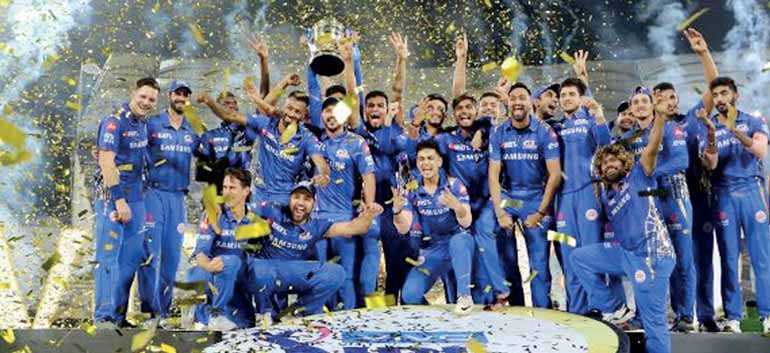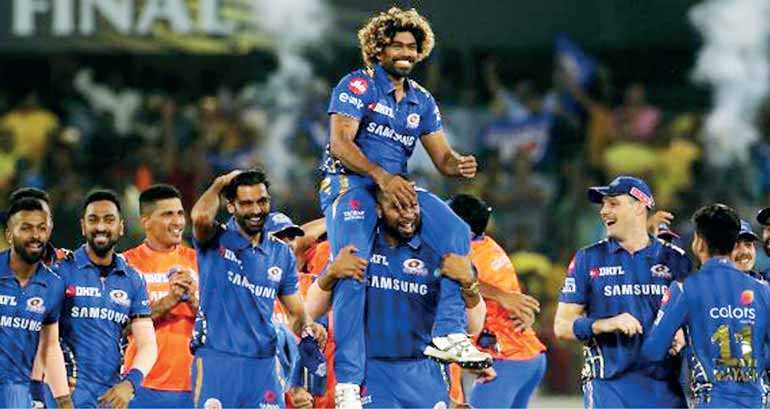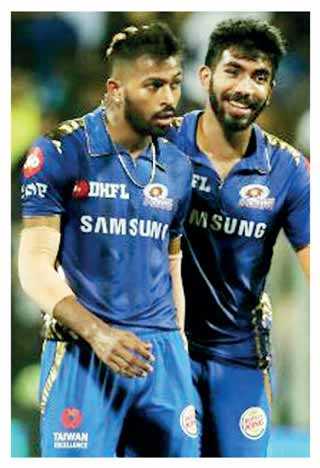Saturday Jan 18, 2025
Saturday Jan 18, 2025
Thursday, 16 May 2019 00:00 - - {{hitsCtrl.values.hits}}


ESPNCricinfo: Before IPL 2019, Mumbai Indians and Chennai Super Kings had three titles each. This season Mumbai owned Super Kings 4-0 to establish themselves as the most successful side in the league. As the dust settles on IPL 2019, ESPNcricinfo looks at the various factors that make Mumbai the powerhouse it is.
The near-perfect squad
Mumbai have bowlers of every variety and batsmen who can tailor their games according to the situation and/or the nature of pitches. Plus there’s experience in the squad. Their captain Rohit Sharma has five IPL titles now – although he forgot at the post-match presentation that he had won one with Deccan Chargers in 2009. Kieron Pollard has played for 16 T20 teams and has won 13 titles. Nobody has more T20 titles than Pollard. The Pandya brothers, who were plucked out of obscurity by Mumbai, lend incredible depth in batting and bowling.
The top-order didn’t get going last year – and Evin Lewis’ form in particular was patchy – so Mumbai smartly traded in Quinton de Kock from Royal Challengers Bangalore ahead of the auction last year. De Kock prefers pace on the ball and loves hitting through the line, which he couldn’t quite do at the Chinnaswamy Stadium, where the pitch was largely two-paced during his stint with Royal Challengers. The Wankhede track, though, suited de Kock’s style and he capped the season as the third-highest run-scorer with 529 runs in 16 innings at a strike-rate of 132.91.
The only ingredient that was missing in Mumbai’s set-up after the auction was an offspinner. Mumbai filled that up as well by roping in Jayant Yadav from Delhi Capitals. Adept at bowling in the Powerplay, Jayant played only two games this season, on the spin-friendly surfaces in Delhi and Chennai, but both his performances contributed to victories. He played a crucial hand in the first qualifier at Chepauk, taking the ball away from Suresh Raina and having him hole out.
“We have a balanced squad whatever the conditions are,” Rohit had said at the post-match presentation after the first qualifier. “If they [the opposition] have right-handers, we have somebody to take the ball away from them. If they have left-handers, we have offspinners. So, we have the balance to play on that kind of a pitch. The batters as well are very confident in what they want to execute, and when you come to a place like Chennai, you need to be clear in what you want to execute as a team and not just as a bowling unit.”
A strong Indian core and scouting system
Hardik Pandya and Jasprit Bumrah – products of Mumbai’s scouting system – have now become the heartbeat and spine of the side. Hardik and Krunal were both spotted by Kiran More when they used to train at his academy in Vadodara. By the time Krunal was snapped up by Mumbai for INR 2 crore in 2016, he had just recovered from a labral tear in his shoulder that had kept him out of action for over a year, but the franchise dared to punt on him. And it has been a mighty successful punt that has made Mumbai’s Indian core mightier.
John Wright, the former India and Mumbai Indians coach, was so impressed with Bumrah in a 20-over Syed Mushtaq Ali Trophy game in 2013 that he fast-tracked him into the Mumbai squad days before IPL 2013, even though the quick had no first-class experience then.
Both Hardik and Bumrah have become world beaters now, and the Mumbai management has given them the freedom to just be themselves. Rohit usually allows Bumrah to set his own fields while coach Mahela Jayawardene said this of Hardik: “We have given him a bit more responsibility – batting him higher in the order in different situations and he has handled it pretty well. And all those decisions that he is making in the middle, we have given that freedom as well.”
On the eve of the IPL final, Jayawardene attributed a large chunk of Mumbai’s sustained success to their scouting system. The likes of John Wright, TA Sekhar, Abey Kuruvilla and More start scouting from as early as October and journey across the country to watch various domestic and age-group tournaments. The talent scouts then meet up every few weeks. Also sitting during this review is Mumbai owner Aakash Ambani, who is understood to be keenly involved in cricketing matters. At the outset of this IPL, Kashmir teenager Rasikh Salam Dar was earmarked by the scouts during the Under-19 Cooch Behar Trophy, where one of his performances included a six-for. Dar got only one game this IPL, but the franchise trusts he could grow into a dependable winner like Bumrah.
Rohit marries smarts with stats
The tournament was on the line. Super Kings needed 2 off the last ball. Lasith Malinga’s first five balls of the last over were either inch-perfect yorkers or hard-to-hit low full-tosses. Shardul Thakur, Rohit’s state-mate and good friend, was on strike for the final ball. Rohit knew Thakur would venture an almighty swing, so he asked Malinga to take pace off the ball and bowl a slower dipping yorker. Rohit planned. Malinga executed. And Mumbai won their record fourth title.
Since Rohit took over as Mumbai captain in 2013, the management has drawn a synergy between analytics and execution on the field. They’re big on match-ups. Case in point: Shane Watson has a glaring weakness against left-arm orthodox spin, so Rohit brought Krunal back into the attack in the 18th over of the chase in the final ahead of Hardik. Krunal was smashed for three successive sixes by Watson, but Rohit has always backed data and his players.
A well thought out plan by Rohit, Mahela, Shane Bond (bowling coach) and Zaheer Khan (director of cricket operations) took down Andre Russell for a golden duck in the final league fixture – a match Mumbai had to win to top the points table. Malinga, who isn’t usually comfortable with bowling from around the wicket, stepped out of his comfort zone against Russell and bounced him out. After winning the final, Rohit revealed that the management had thoroughly studied Russell’s weakness against the short ball from around the wicket for a week, and then nailed it on the field.
“We do believe in each other’s ability and we do believe in planning strategies,” Rohit said. “Luckily for me, I have a staff around me which is so good at that, in terms of planning and making those crucial decisions and strategies. Because I am a firm believer in having planning. Whatever game you play, you have to go with a plan and have some sort of strategies around the opposition. I’ve seen IPL from close quarters, you need to be a little dynamic.
“For example, against KKR, Malinga has never bowled around the wicket to any batsman. So, he came and bowled to Andre Russell, and he got him out. That was sheer planning. We went through his videos as well to see what sort of movements he creates when he bats, so we thought coming round the wicket will be an ideal option for him and bowl that bouncer. That’s an example I gave you, but overall what I want to say is strategies and planning do help and we’re very good at what we do here.”
Wisdom over emotion
Former India senior Yuvraj Singh started the season for Mumbai and although he scored 53 off 35 balls in the first match against Capitals, he struggled in the next three games and was swapped out in favour of Ishan Kishan, who peaked in the playoffs. He made a vital 28 off 31 balls on a Chepauk turner and helped Mumbai nullify Super Kings’ spin threat in the first qualifier. Then, in the final, Kishan effected a direct hit to run MS Dhoni out and pull Mumbai ahead in a cat-and-mouse chase.
Mayank Markande, another product of Mumbai’s scouting system, was a revelation last season, so much so he became an India player nearly a year after making his IPL debut. Like Yuvraj, Markande started the season, but his form tailed off and it was over to Rahul Chahar, who did not get a single game last season despite being bought for INR 1.9 cr ($296,000 approx then), compared to Markande who was picked at 20 lakhs ($31,000 approx). This IPL, Chahar excelled in the Powerplay as well as middle overs, delivering key breakthroughs. All told, Chahar collected 13 wickets in as many matches at an outstanding economy rate of 6.55. As much as Bumrah captured headlines for his performance in the final, Chahar’s 2 for 14 in four overs was equally instrumental in Mumbai’s triumph.
And what about Malinga? He was injured last season, but Mumbai wanted to have him on board as a bowling mentor. He worked on his fitness this year, found his rhythm in the unheralded Global T20 Canada and then played in the BPL for Khulna Titans, which are coached by Jayawardene.
Jayawaradene was impressed with what he saw of Malinga and got him back as a player for Mumbai. Malinga had a torrid time in the Powerplay and later in the field in the final, but Rohit and Jayawardene backed him to deliver the title. And deliver he did.
“It’s important we trust a group of players,” Jayawardene said. “And we identify the guys who are performing and who is in form and once you’re transparent about that everyone understands what’s the best XI and they pick themselves quite easily. Mayank [Markande] started the season, but we felt Rahul [Chahar] was bowling much better and his rhythm was better. So, we went with that option.
“Same with Lasith [Malinga]. Last year, Lasith was injured and not in great form. This year we thought he was back in form and would be a good foil for [Jasprit] Bumrah because at the back end, lots of teams are leaking runs in that department. So, we want to have experience there. So, it’s a collective decision. It’s not an easy one, but as long as you’re honest and there’s a process behind the decision-making, things become easier and the entire group understands that and that’s transparent. That has helped us become consistent over the years and that’s been a part of the success as well as they come out and play fearless cricket in that environment.”